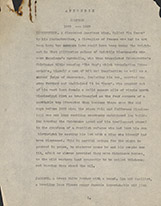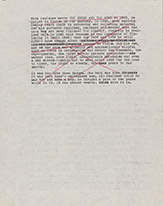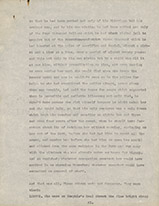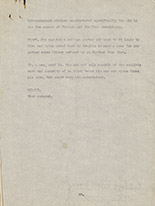Manuscripts Etc.
| CLOSE WINDOW |

|
The following items are drawn from the William Faulkner Foundation Collection at the University of Virginia's Albert and Shirley Small Special Collections Library (http://small.library.virginia.edu/). |
|
We owe the existence of "Appendix Compson" to Malcolm Cowley, who in the mid-1940s decided to edit a volume for the series of Portables that Viking Press began bringing out in 1943. Cowley's professed goal was to appreciate Faulkner's achievement in creating the larger Yoknapatawpha saga, as Faulkner had developed that saga across two decades and as Cowley could represent it in a broad range of stories and selected excerpts from novels. As part of that project, he wrote Faulkner, he hoped to use the fourth and last section of The Sound and the Fury, which he refers to as "the story called 'Dilsey,'" but wasn't sure it could stand as a separate narrative. In reply Faulkner offered to prepare "a page or two of synopsis" of the rest of the novel to accompany that selection. Instead, however, he wrote the "Appendix." When he received the 22-page typescript Cowley was delighted, but in his role as editor had a number of what he called "perplexing questions" for Faulkner about "discrepancies" between the earlier novel and this new fifth section, which led to a series of exchanges between author and editor "through the winter" of 1945-1946. At the end of this process each man made a few revisions in "Appendix" before it appeared in the Portable. For example, on the first page (below left) Faulkner says that his French friend called Ikkemotubbe "du Homme"; Cowley queried Faulkner's French, Faulkner defended the ungrammatical phrase, but ultimately gave Cowley permission to change it to the more correct "l'Homme' and sometimes 'de l'Homme.'" The typescript in the Faulkner Foundation Collection says "du Homme," which allows us to identify the undated document as the copy Faulkner made and kept when in October 1945 he mailed Cowley the "ribbon" or top copy of the typescript. That copy is lost - but it's safe to say that that is the document that editor and author mailed back and forth during the winter, on which the editor raised questions and the author provided his replies. Below right: This appears to be a draft of an introductory note to the "Appendix" written by Faulkner sometime after the Portable Faulkner was published. Noel Polk found it on the back of one of the pages of a typescript of Faulkner's non-Yoknapatawpha novel A Fable, and had it printed in facsimile in the first of the two volumes on The Sound and the Fury that he edited for Garland's William Faulkner Manuscripts series. A Fable appeared in 1954, so this note had to be written before then, but it's most likely that Faulkner wrote it for possible use in the combined edition of The Sound and the Fury and As I Lay Dying that Random House brought out in 1946. For that volume Faulkner made some further revisions in the "Appendix" - in some cases restoring changes Cowley had made, including reverting to "du Homme" - and insisted that Random House use the title "Appendix Compson" for it but publish it before the rest of the novel, which is the way it appears in that volume. Polk's volume was the first time this note was ever published.   Cowley's list of the "discrepancies" between novel and "Appendix" included questions about how much money Caddy's daughter ran off with, where Jason kept the money hidden, whether she climbed down a tree or a rainpipe - and one about "the two Negro boys" mentioned at the end, Luster and TP: which "was older?" As you can see below, Faulkner switched TP (Dilsey's son) and Luster (her grandson), making TP the 14-year-old who accompanies Benjy in his section, and Luster the male who parades in the streets of Memphis. Faulkner had made a similar change - perhaps we should just say "mistake" - when he has Luster hunting with Quentin Compson and his father in Absalom!, even though Luster wasn't born until after Quentin's suicide. In the letters Faulkner wrote back to Cowley he addresses all the inconsistencies except this one, and so we can't say whether he himself, or Cowley, straightened out the Gibson family before the publication of the Portable, where TP and Luster are "in their ordered place" in the Gibson genealogy.   There's one other change Cowley proposed and Faulkner acceded to in these Gibson entries. Where the typescript says "Jew owners" of urban sweatshops," Cowley asked permission to drop the ethnic adjective - perhaps we should just say ethnic stereotype - telling the author that "I'd rather not see a false argument over anti-Semitism injected into the reviews." In his comment on this proposal Faulkner wrote "All right," and in the Portable version of the "Appendix" the phrase is simply "the owners." But someone, presumably Faulkner, restored it to the various Random House editions of The Sound and the Fury, as well as the Vintage International paperback that is our text for this project. SOURCES: Cowley, The Portable Faulkner: Revised and Expanded Edition; Cowley, The Faulkner-Cowley File; Polk, ed., William Faulkner Manuscripts 6, Volume 1: The Sound and the Fury, Holograph Manuscript and Miscellaneous Pages. Citing this source: |
